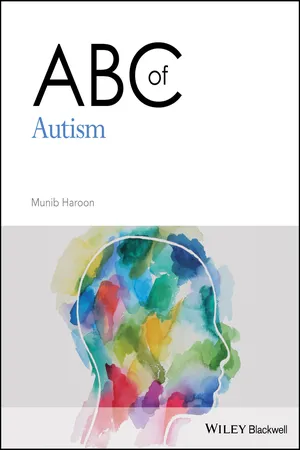ABC of Autism
About this book
ABC of Autism provides clinicians and medical students with a succinct, evidence-based overview of the symptoms, evaluation, treatment, and management of autism in both daily practice and for ongoing patient support plans. This accessible and informative guide allows primary healthcare professionals to quickly reference the essential information required for appropriate patient care.
Compact yet comprehensive, this book offers concise and focused chapters covering topics ranging from basic epidemiology and key diagnostic features to managing behavioural difficulties and co-morbidities, such as ADHD and dyspraxia. Full-colour illustrations reinforce understanding of the condition while actual case studies demonstrate contemporary practices and real-life scenarios.
ABC of Autism is a valuable resource for GPs, paediatricians, speech therapists, educational psychologists, medical and nursing students, and practitioners responsible for coordinating multidisciplinary care for patients with autism.
Frequently asked questions
- Essential is ideal for learners and professionals who enjoy exploring a wide range of subjects. Access the Essential Library with 800,000+ trusted titles and best-sellers across business, personal growth, and the humanities. Includes unlimited reading time and Standard Read Aloud voice.
- Complete: Perfect for advanced learners and researchers needing full, unrestricted access. Unlock 1.4M+ books across hundreds of subjects, including academic and specialized titles. The Complete Plan also includes advanced features like Premium Read Aloud and Research Assistant.
Please note we cannot support devices running on iOS 13 and Android 7 or earlier. Learn more about using the app.
Information
CHAPTER 1
An Introduction to Autism
OVERVIEW
- Autism is a relatively common neurodevelopmental condition with a prevalence of over 1% in many populations.
- Autism is defined by the presence of social communication and social interaction difficulties and restricted, repetitive patterns of behaviour, interests and activities which can vary in severity.
- Autism has a heterogeneous clinical presentation because of variations in the core features and the presence or absence of associated conditions.
- The diagnosis of autism is a clinical diagnosis.
- There is no cure for autism but early intervention can have a significant impact upon overall well‐being.
Definition

History

Epidemiology
Aetiology
Clinical features
Diagnosis
Table of contents
- Cover
- Table of Contents
- Contributors
- Acknowledgements
- Abbreviations
- CHAPTER 1: An Introduction to Autism
- CHAPTER 2: Classification and Diagnosis
- CHAPTER 3: The Aetiology of Autism
- CHAPTER 4: The Features of Autism in Childhood
- CHAPTER 5: The Assessment and Diagnosis of Autism in Children
- CHAPTER 6: Managing Day-to-Day Issues
- CHAPTER 7: Mental Health in Children With Autism
- CHAPTER 8: School and Autism
- CHAPTER 9: Symptoms and Signs in Adult Autism
- CHAPTER 10: The Assessment and Diagnosis of Autism in Adults
- CHAPTER 11: Autism and Mental Health in Adult Patients
- CHAPTER 12: Learning Disabilities and Autism
- CHAPTER 13: Gender and Autism
- CHAPTER 14: Getting On With Life As an Adult After a Diagnosis
- CHAPTER 15: Mortality and Autism
- CHAPTER 16: Interventions for Autism in Children and Adults
- Index
- End User License Agreement
